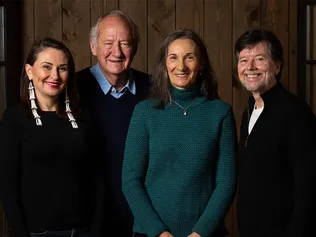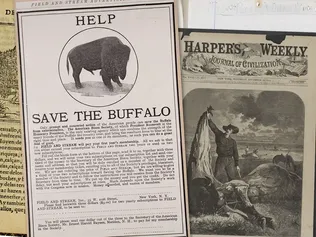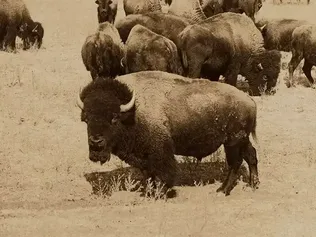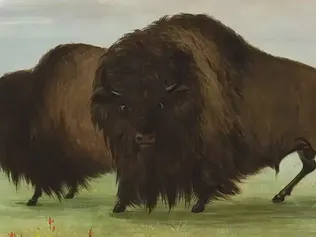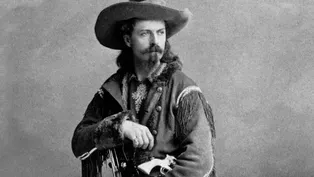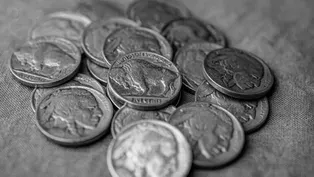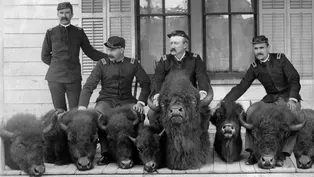
Sitting Bull and the Wounded Knee Massacre
Clip: 10/17/2023 | 6m 21sVideo has Closed Captions
More than 250 Lakotas – mostly women and children – were killed by U.S. soldiers.
U.S. concern over a new Ghost Dance ceremony prompted the arrest of the Lakota Chief Sitting Bull. Dozens ended up dead, including Sitting Bull. Several hundred Lakotas headed toward the Black Hills to end things peaceably with the U.S. Army. En route, they camped at a creek called Wounded Knee. The next morning, more than 250 Lakotas – mostly women and children – were killed by U.S. soldiers.
Corporate funding for The American Buffalo was provided by Bank of America. Major funding was provided by the Corporation for Public Broadcasting, and by The Better Angels Society and its...

Sitting Bull and the Wounded Knee Massacre
Clip: 10/17/2023 | 6m 21sVideo has Closed Captions
U.S. concern over a new Ghost Dance ceremony prompted the arrest of the Lakota Chief Sitting Bull. Dozens ended up dead, including Sitting Bull. Several hundred Lakotas headed toward the Black Hills to end things peaceably with the U.S. Army. En route, they camped at a creek called Wounded Knee. The next morning, more than 250 Lakotas – mostly women and children – were killed by U.S. soldiers.
How to Watch The American Buffalo
The American Buffalo is available to stream on pbs.org and the free PBS App, available on iPhone, Apple TV, Android TV, Android smartphones, Amazon Fire TV, Amazon Fire Tablet, Roku, Samsung Smart TV, and Vizio.
Buy Now
Providing Support for PBS.org
Learn Moreabout PBS online sponsorshipAt the same time, the aging Hunkpapa Lakota leader Sitting Bull had been touring with Buffalo Bill Cody's Wild West Show, where he was paid to ride around the arena once during each performance, promoted as "the slayer of General Custer."
He also signed pictures of himself for the awestruck visitors who came to his tepee.
But after 4 months with Cody, Sitting Bull had seen enough of the White world.
He could not understand why beggars were ignored on the streets of big cities, and he gave much of his pay away to the hoboes and newsboys he met.
Back at the Standing Rock Reservation in Dakota Territory, he used the money he had left to provide feasts for his friends.
♪ Horse Capture, Jr.: Some of this is very hard to put into words.
But sometimes there'd be a certain amount of emptiness in a spot.
You can have this emptiness and you can't identify it.
It's only an emptiness, you know, and it's...maybe that would have been a part of it.
But, also, we got a lot of things that are--that are gone.
That are gone.
Narrator: In 1890, a summer drought killed whatever crops the Lakotas were trying to raise.
The government had already cut rations at every reservation by more than 20%.
Whooping cough and influenza spread among the hungry people, particularly the children.
♪ Then, word arrived that a new ceremony called the Ghost Dance was sweeping through many tribes of the West.
Preached by a Paiute medicine man and combining Christian as well as Indian elements, it offered dispirited Native Americans hope.
Man: My brothers, I bring you word from your fathers, the ghosts, that they are marching now to join you, led by the Messiah who came once to live on Earth with the White man, but was killed by them.
I bring to you the promise of the day in which there will be no White man to lay his hand on the bridle of an Indian's horse; when the red men of the prairie will rule the world.
Wovoka.
♪ Narrator: Wovoka's prophecy required men and women to purify themselves, give up alcohol, and forswear violence.
Then, they were to dance in a large circle, singing and calling upon the spirits of their ancestors.
If they did, the Ghost Dancers believed, the Whites would vanish and the buffalo would cover the Plains again.
"Give me my arrows," they sang as they danced.
"The buffalo are coming, the buffalo are coming."
♪ Though he lived in New York City, the naturalist and writer George Bird Grinnell spent parts of every year living among the Pawnee, Blackfeet, and Cheyenne, listening to their stories, studying their religion, learning their history.
In the fall of 1890, he watched the Cheyenne hold a Ghost Dance.
Grinnell understood the appeal of its message.
"This is only what any of us will do," he wrote, "if we get hungry."
♪ In the Lakotas' adaptation of the ceremony, Ghost Dancers wore special shirts, said to be impervious to the White man's bullets.
Government agents became alarmed, fearing an uprising was imminent.
As a precautionary measure, Indian police at the Standing Rock Reservation were ordered to arrest the most prominent Lakota chief-- Sitting Bull.
When some of his followers resisted, a fight broke out.
Both sides began firing and a dozen people were killed.
Sitting Bull was one of them.
♪ Several hundred Lakotas, flying a white flag, headed toward the Black Hills, and planned to turn themselves over to the U.S. Army to settle things peaceably before more blood was shed.
They encamped one night at a creek called Wounded Knee.
♪ The next morning, December 29th, 1890, soldiers armed with 4 devastating Hotchkiss guns encircled the camp and began confiscating the Indians' weapons.
[Gunshot] Someone's gun went off.
[Gunfire] The soldiers opened fire.
When the shooting stopped, more than 250 Lakotas-- most of them women and children--were dead.
So were 25 soldiers.
Horse Capture, Jr.: What was they trying to do?
They was trying to dance their ways back.
They were praying.
They tried to dance the buffalo back.
You know?
And they paid with their lives.
♪ Man as Grinnell: The most shameful chapter of American history is that in which is recorded the account of our dealings with the Indians.
The story of our government's relations with this race is an unbroken narrative of injustice, fraud, and robbery.
We are too apt to forget that these people are humans like ourselves, that they are fathers and mothers, husbands and wives, brothers and sisters, men and women with emotions and passions like our own.
George Bird Grinnell.
♪
Buffalo Bill and His Wild West Show
Video has Closed Captions
By 1889, Buffalo Bill Cody was the most famous American in the world. (5m 23s)
The Buffalo Nickel and Bison Facts Today
Video has Closed Captions
The 1913 Buffalo Nickel raises important questions how we think of the American West. (9m 15s)
George Bird Grinnell and Early Conservation Efforts
Video has Closed Captions
Grinnell fought the destruction of birds and other wildlife, including the buffalo. (6m 25s)
Providing Support for PBS.org
Learn Moreabout PBS online sponsorshipCorporate funding for The American Buffalo was provided by Bank of America. Major funding was provided by the Corporation for Public Broadcasting, and by The Better Angels Society and its...

